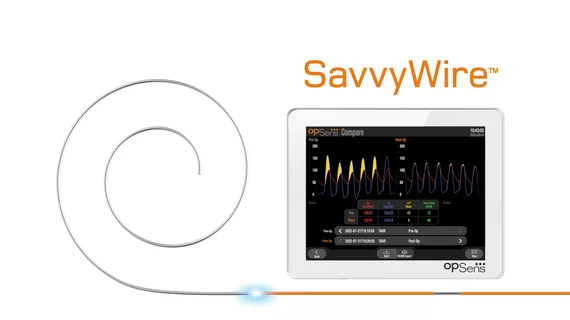New 3-in-1 TAVR guidewire capable of hemodynamic measurements, LV pacing impresses cardiologists
A new transcatheter aortic valve replacement (TAVR) guidewire designed to provide continuous hemodynamic measurements and left ventricular (LV) pacing appears to be safe and effective, according to new research published in JACC: Cardiovascular Interventions.[1] The study’s authors think the device could help improve clinical decision-making after heart valve deployment.
“The number of TAVR procedures is anticipated to rise in the near future, particularly among younger patients with low-risk profiles,” wrote first author Ander Regueiro, MSc, PhD, an interventional cardiologist with Hospital Clinic Barcelona in Spain, and colleagues. “Given this trend, the necessity for continuous technological innovation and procedural refinement is underscored. These efforts are integral to minimizing periprocedural complications linked to TAVR, endorsing a minimalistic approach, and enhancing the clinical outcomes following TAVR.”
Regueiro et al. focused on the SavvyWire guidewire, a sensor-guided device developed by OpSens Medical, a Canadian medical device company. According to OpSens, the SavvyWire is the first interventional device of its kind. It provides assistance with aortic valve delivery and positioning, like any guidewire, but it also includes sensors that enable continuous hemodynamic measurements and rapid LV pacing.
In October, Haemonetics Corp. agreed to acquire OpSens for approximately $253 million.
The SAFE-TAVI clinical trial, funded by OpSens, included data from 119 patients treated with the 3-in-1 device. The mean patient age was 82.3 years old, and 50.4% of patients were men. Approximately 38% of patients were treated with a balloon-expandable TAVR valve.
Overall, TAVR procedures performed using the SavvyWire were found to be both safe and effective. The study’s primary efficacy endpoint—drops of systolic pressure below 60 mm Hg—was seen in 98.3% of patients. The secondary efficacy endpoint, hemodynamic assessments without the use of additional catheters, was seen in 99.2% of patients. Meanwhile, the mean systolic arterial pressure achieved during rapid LV pacing was 46.6 mm Hg.
A key safety endpoint, freedom from major guidewire-related complications, was also seen in 99.2% of patients. No deaths, strokes or cases of ventricular perforation were reported.
“This paper provides comprehensive data from the SAFE-TAVI trial, which successfully evaluates the guidewire in TAVR procedures across a broad patient cohort and various valve systems,” the authors wrote. “It reports high success in meeting primary efficacy and safety endpoints, enhancing the evidence for the device’s utility in TAVR.”
The group also noted that future studies should examine the long-term clinical benefits of this technology.
Read the full study in JACC: Cardiovascular Interventions, a journal from the American College of Cardiology.

